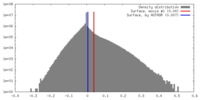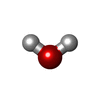[English] 日本語
 Yorodumi
Yorodumi- EMDB-3883: High-resolution cryo-EM structure of the human 80S ribosome - (co... -
+ Open data
Open data
- Basic information
Basic information
| Entry | Database: EMDB / ID: EMD-3883 | |||||||||
|---|---|---|---|---|---|---|---|---|---|---|
| Title | High-resolution cryo-EM structure of the human 80S ribosome - (composite structure) | |||||||||
 Map data Map data | Human 80S ribosome high-resolution cryo-EM map | |||||||||
 Sample Sample |
| |||||||||
| Function / homology |  Function and homology information Function and homology informationtranslation at presynapse / exit from mitosis / eukaryotic 80S initiation complex / negative regulation of protein neddylation / optic nerve development / response to insecticide / regulation of translation involved in cellular response to UV / oxidized pyrimidine DNA binding / response to TNF agonist / negative regulation of endoplasmic reticulum unfolded protein response ...translation at presynapse / exit from mitosis / eukaryotic 80S initiation complex / negative regulation of protein neddylation / optic nerve development / response to insecticide / regulation of translation involved in cellular response to UV / oxidized pyrimidine DNA binding / response to TNF agonist / negative regulation of endoplasmic reticulum unfolded protein response / positive regulation of base-excision repair / axial mesoderm development / negative regulation of formation of translation preinitiation complex / regulation of G1 to G0 transition / positive regulation of respiratory burst involved in inflammatory response / positive regulation of intrinsic apoptotic signaling pathway in response to DNA damage / ribosomal protein import into nucleus / positive regulation of gastrulation / protein tyrosine kinase inhibitor activity / protein-DNA complex disassembly / IRE1-RACK1-PP2A complex / 90S preribosome assembly / positive regulation of endodeoxyribonuclease activity / nucleolus organization / positive regulation of intrinsic apoptotic signaling pathway in response to DNA damage by p53 class mediator / positive regulation of Golgi to plasma membrane protein transport / retinal ganglion cell axon guidance / TNFR1-mediated ceramide production / negative regulation of DNA repair / negative regulation of RNA splicing / GAIT complex / positive regulation of DNA damage response, signal transduction by p53 class mediator / supercoiled DNA binding / TORC2 complex binding / alpha-beta T cell differentiation / neural crest cell differentiation / G1 to G0 transition / NF-kappaB complex / cysteine-type endopeptidase activator activity involved in apoptotic process / oxidized purine DNA binding / positive regulation of ubiquitin-protein transferase activity / negative regulation of intrinsic apoptotic signaling pathway in response to hydrogen peroxide / regulation of establishment of cell polarity / negative regulation of bicellular tight junction assembly / ubiquitin-like protein conjugating enzyme binding / middle ear morphogenesis / negative regulation of phagocytosis / rRNA modification in the nucleus and cytosol / Formation of the ternary complex, and subsequently, the 43S complex / erythrocyte homeostasis / cytoplasmic side of rough endoplasmic reticulum membrane / laminin receptor activity / negative regulation of ubiquitin protein ligase activity / protein kinase A binding / ion channel inhibitor activity / Ribosomal scanning and start codon recognition / pigmentation / homeostatic process / Translation initiation complex formation / positive regulation of mitochondrial depolarization / macrophage chemotaxis / positive regulation of T cell receptor signaling pathway / negative regulation of Wnt signaling pathway / fibroblast growth factor binding / lung morphogenesis / male meiosis I / monocyte chemotaxis / positive regulation of activated T cell proliferation / positive regulation of natural killer cell proliferation / negative regulation of translational frameshifting / TOR signaling / Protein hydroxylation / BH3 domain binding / SARS-CoV-1 modulates host translation machinery / regulation of adenylate cyclase-activating G protein-coupled receptor signaling pathway / cellular response to ethanol / regulation of cell division / iron-sulfur cluster binding / mTORC1-mediated signalling / Peptide chain elongation / Selenocysteine synthesis / Formation of a pool of free 40S subunits / positive regulation of intrinsic apoptotic signaling pathway by p53 class mediator / endonucleolytic cleavage to generate mature 3'-end of SSU-rRNA from (SSU-rRNA, 5.8S rRNA, LSU-rRNA) / Eukaryotic Translation Termination / ubiquitin ligase inhibitor activity / positive regulation of GTPase activity / cellular response to actinomycin D / blastocyst development / Response of EIF2AK4 (GCN2) to amino acid deficiency / SRP-dependent cotranslational protein targeting to membrane / negative regulation of ubiquitin-dependent protein catabolic process / positive regulation of signal transduction by p53 class mediator / protein serine/threonine kinase inhibitor activity / Viral mRNA Translation / negative regulation of respiratory burst involved in inflammatory response / Nonsense Mediated Decay (NMD) independent of the Exon Junction Complex (EJC) / protein localization to nucleus / GTP hydrolysis and joining of the 60S ribosomal subunit / L13a-mediated translational silencing of Ceruloplasmin expression Similarity search - Function | |||||||||
| Biological species |  Homo sapiens (human) / Homo sapiens (human) /  Human (human) Human (human) | |||||||||
| Method | single particle reconstruction / cryo EM / Resolution: 2.9 Å | |||||||||
 Authors Authors | Natchiar SK / Myasnikov AG / Kratzat H / Hazemann I / Klaholz BP | |||||||||
 Citation Citation |  Journal: Nature / Year: 2017 Journal: Nature / Year: 2017Title: Visualization of chemical modifications in the human 80S ribosome structure. Authors: S Kundhavai Natchiar / Alexander G Myasnikov / Hanna Kratzat / Isabelle Hazemann / Bruno P Klaholz /  Abstract: Chemical modifications of human ribosomal RNA (rRNA) are introduced during biogenesis and have been implicated in the dysregulation of protein synthesis, as is found in cancer and other diseases. ...Chemical modifications of human ribosomal RNA (rRNA) are introduced during biogenesis and have been implicated in the dysregulation of protein synthesis, as is found in cancer and other diseases. However, their role in this phenomenon is unknown. Here we visualize more than 130 individual rRNA modifications in the three-dimensional structure of the human ribosome, explaining their structural and functional roles. In addition to a small number of universally conserved sites, we identify many eukaryote- or human-specific modifications and unique sites that form an extended shell in comparison to bacterial ribosomes, and which stabilize the RNA. Several of the modifications are associated with the binding sites of three ribosome-targeting antibiotics, or are associated with degenerate states in cancer, such as keto alkylations on nucleotide bases reminiscent of specialized ribosomes. This high-resolution structure of the human 80S ribosome paves the way towards understanding the role of epigenetic rRNA modifications in human diseases and suggests new possibilities for designing selective inhibitors and therapeutic drugs. | |||||||||
| History |
|
- Structure visualization
Structure visualization
| Movie |
 Movie viewer Movie viewer |
|---|---|
| Structure viewer | EM map:  SurfView SurfView Molmil Molmil Jmol/JSmol Jmol/JSmol |
| Supplemental images |
- Downloads & links
Downloads & links
-EMDB archive
| Map data |  emd_3883.map.gz emd_3883.map.gz | 52.1 MB |  EMDB map data format EMDB map data format | |
|---|---|---|---|---|
| Header (meta data) |  emd-3883-v30.xml emd-3883-v30.xml emd-3883.xml emd-3883.xml | 94 KB 94 KB | Display Display |  EMDB header EMDB header |
| FSC (resolution estimation) |  emd_3883_fsc.xml emd_3883_fsc.xml emd_3883_fsc_1.xml emd_3883_fsc_1.xml emd_3883_fsc_2.xml emd_3883_fsc_2.xml emd_3883_fsc_3.xml emd_3883_fsc_3.xml | 22.4 KB 22.4 KB 22.4 KB 22.4 KB | Display Display Display Display |  FSC data file FSC data file |
| Images |  emd_3883.png emd_3883.png | 222.4 KB | ||
| Archive directory |  http://ftp.pdbj.org/pub/emdb/structures/EMD-3883 http://ftp.pdbj.org/pub/emdb/structures/EMD-3883 ftp://ftp.pdbj.org/pub/emdb/structures/EMD-3883 ftp://ftp.pdbj.org/pub/emdb/structures/EMD-3883 | HTTPS FTP |
-Validation report
| Summary document |  emd_3883_validation.pdf.gz emd_3883_validation.pdf.gz | 77.7 KB | Display |  EMDB validaton report EMDB validaton report |
|---|---|---|---|---|
| Full document |  emd_3883_full_validation.pdf.gz emd_3883_full_validation.pdf.gz | 76.8 KB | Display | |
| Data in XML |  emd_3883_validation.xml.gz emd_3883_validation.xml.gz | 497 B | Display | |
| Data in CIF |  emd_3883_validation.cif.gz emd_3883_validation.cif.gz | 192 B | Display | |
| Arichive directory |  https://ftp.pdbj.org/pub/emdb/validation_reports/EMD-3883 https://ftp.pdbj.org/pub/emdb/validation_reports/EMD-3883 ftp://ftp.pdbj.org/pub/emdb/validation_reports/EMD-3883 ftp://ftp.pdbj.org/pub/emdb/validation_reports/EMD-3883 | HTTPS FTP |
-Related structure data
| Related structure data |  6qzpMC  4243C  4244C  4245C  4263C  6ek0 C: citing same article ( M: atomic model generated by this map |
|---|---|
| Similar structure data |
- Links
Links
| EMDB pages |  EMDB (EBI/PDBe) / EMDB (EBI/PDBe) /  EMDataResource EMDataResource |
|---|---|
| Related items in Molecule of the Month |
- Map
Map
| File |  Download / File: emd_3883.map.gz / Format: CCP4 / Size: 1000 MB / Type: IMAGE STORED AS FLOATING POINT NUMBER (4 BYTES) Download / File: emd_3883.map.gz / Format: CCP4 / Size: 1000 MB / Type: IMAGE STORED AS FLOATING POINT NUMBER (4 BYTES) | ||||||||||||||||||||||||||||||||||||||||||||||||||||||||||||
|---|---|---|---|---|---|---|---|---|---|---|---|---|---|---|---|---|---|---|---|---|---|---|---|---|---|---|---|---|---|---|---|---|---|---|---|---|---|---|---|---|---|---|---|---|---|---|---|---|---|---|---|---|---|---|---|---|---|---|---|---|---|
| Annotation | Human 80S ribosome high-resolution cryo-EM map | ||||||||||||||||||||||||||||||||||||||||||||||||||||||||||||
| Projections & slices | Image control
Images are generated by Spider. | ||||||||||||||||||||||||||||||||||||||||||||||||||||||||||||
| Voxel size | X=Y=Z: 0.85 Å | ||||||||||||||||||||||||||||||||||||||||||||||||||||||||||||
| Density |
| ||||||||||||||||||||||||||||||||||||||||||||||||||||||||||||
| Symmetry | Space group: 1 | ||||||||||||||||||||||||||||||||||||||||||||||||||||||||||||
| Details | EMDB XML:
CCP4 map header:
| ||||||||||||||||||||||||||||||||||||||||||||||||||||||||||||
-Supplemental data
- Sample components
Sample components
+Entire : 80S ribosome with ligand HHT and HYG
+Supramolecule #1: 80S ribosome with ligand HHT and HYG
+Macromolecule #1: 28S ribosomal RNA
+Macromolecule #2: 5S ribosomal RNA
+Macromolecule #3: 5.8S ribosomal RNA
+Macromolecule #47: 18S ribosomal RNA
+Macromolecule #48: Human initiator Met-tRNA-i
+Macromolecule #4: 60S ribosomal protein L8
+Macromolecule #5: 60S ribosomal protein L3
+Macromolecule #6: 60S ribosomal protein L4
+Macromolecule #7: 60S ribosomal protein L5
+Macromolecule #8: 60S ribosomal protein L6
+Macromolecule #9: 60S ribosomal protein L7
+Macromolecule #10: 60S ribosomal protein L7a
+Macromolecule #11: 60S ribosomal protein L9
+Macromolecule #12: 60S ribosomal protein L10-like
+Macromolecule #13: 60S ribosomal protein L11
+Macromolecule #14: 60S ribosomal protein L13
+Macromolecule #15: 60S ribosomal protein L14
+Macromolecule #16: 60S ribosomal protein L15
+Macromolecule #17: 60S ribosomal protein L13a
+Macromolecule #18: 60S ribosomal protein L17
+Macromolecule #19: 60S ribosomal protein L18
+Macromolecule #20: 60S ribosomal protein L19
+Macromolecule #21: 60S ribosomal protein L18a
+Macromolecule #22: 60S ribosomal protein L21
+Macromolecule #23: 60S ribosomal protein L22
+Macromolecule #24: 60S ribosomal protein L23
+Macromolecule #25: 60S ribosomal protein L24
+Macromolecule #26: 60S ribosomal protein L23a
+Macromolecule #27: 60S ribosomal protein L26
+Macromolecule #28: 60S ribosomal protein L27
+Macromolecule #29: 60S ribosomal protein L27a
+Macromolecule #30: 60S ribosomal protein L29
+Macromolecule #31: 60S ribosomal protein L30
+Macromolecule #32: 60S ribosomal protein L31
+Macromolecule #33: 60S ribosomal protein L32
+Macromolecule #34: 60S ribosomal protein L35a
+Macromolecule #35: 60S ribosomal protein L34
+Macromolecule #36: 60S ribosomal protein L35
+Macromolecule #37: 60S ribosomal protein L36
+Macromolecule #38: 60S ribosomal protein L37
+Macromolecule #39: 60S ribosomal protein L38
+Macromolecule #40: 60S ribosomal protein L39
+Macromolecule #41: Ubiquitin-60S ribosomal protein L40
+Macromolecule #42: 60S ribosomal protein L41
+Macromolecule #43: 60S ribosomal protein L36a
+Macromolecule #44: 60S ribosomal protein L37a
+Macromolecule #45: 60S ribosomal protein L28
+Macromolecule #46: 60S ribosomal protein L10a
+Macromolecule #49: 40S ribosomal protein SA
+Macromolecule #50: 40S ribosomal protein S3a
+Macromolecule #51: 40S ribosomal protein S3
+Macromolecule #52: 40S ribosomal protein S4, X isoform
+Macromolecule #53: 40S ribosomal protein S5
+Macromolecule #54: 40S ribosomal protein S7
+Macromolecule #55: 40S ribosomal protein S8
+Macromolecule #56: 40S ribosomal protein S10
+Macromolecule #57: 40S ribosomal protein S11
+Macromolecule #58: 40S ribosomal protein S15
+Macromolecule #59: 40S ribosomal protein S16
+Macromolecule #60: 40S ribosomal protein S17
+Macromolecule #61: 40S ribosomal protein S18
+Macromolecule #62: 40S ribosomal protein S19
+Macromolecule #63: 40S ribosomal protein S20
+Macromolecule #64: 40S ribosomal protein S21
+Macromolecule #65: 40S ribosomal protein S23
+Macromolecule #66: 40S ribosomal protein S26
+Macromolecule #67: 40S ribosomal protein S28
+Macromolecule #68: 40S ribosomal protein S29
+Macromolecule #69: Receptor of activated protein C kinase 1
+Macromolecule #70: 40S ribosomal protein S2
+Macromolecule #71: 40S ribosomal protein S6
+Macromolecule #72: 40S ribosomal protein S9
+Macromolecule #73: 40S ribosomal protein S12
+Macromolecule #74: 40S ribosomal protein S13
+Macromolecule #75: 40S ribosomal protein S14
+Macromolecule #76: 40S ribosomal protein S15a
+Macromolecule #77: 40S ribosomal protein S24
+Macromolecule #78: 40S ribosomal protein S25
+Macromolecule #79: 40S ribosomal protein S27
+Macromolecule #80: 40S ribosomal protein S30
+Macromolecule #81: Ubiquitin-40S ribosomal protein S27a
+Macromolecule #82: MAGNESIUM ION
+Macromolecule #83: (3beta)-O~3~-[(2R)-2,6-dihydroxy-2-(2-methoxy-2-oxoethyl)-6-methy...
+Macromolecule #84: ZINC ION
+Macromolecule #85: HYGROMYCIN B
+Macromolecule #86: water
-Experimental details
-Structure determination
| Method | cryo EM |
|---|---|
 Processing Processing | single particle reconstruction |
| Aggregation state | particle |
- Sample preparation
Sample preparation
| Concentration | 0.5 mg/mL |
|---|---|
| Buffer | pH: 7.5 / Details: 100mM KCl, 5mM MgAc2, 20mM Hepes, 10mM NH4Cl |
| Vitrification | Cryogen name: ETHANE / Chamber humidity: 100 % / Chamber temperature: 283 K / Instrument: FEI VITROBOT MARK IV |
- Electron microscopy
Electron microscopy
| Microscope | FEI TITAN KRIOS |
|---|---|
| Image recording | Film or detector model: FEI FALCON II (4k x 4k) / Average electron dose: 3.5 e/Å2 |
| Electron beam | Acceleration voltage: 300 kV / Electron source:  FIELD EMISSION GUN FIELD EMISSION GUN |
| Electron optics | Illumination mode: SPOT SCAN / Imaging mode: BRIGHT FIELD |
| Sample stage | Specimen holder model: FEI TITAN KRIOS AUTOGRID HOLDER |
| Experimental equipment |  Model: Titan Krios / Image courtesy: FEI Company |
- Image processing
Image processing
-Atomic model buiding 1
| Refinement | Protocol: OTHER |
|---|---|
| Output model |  PDB-6qzp: |
 Movie
Movie Controller
Controller







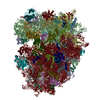






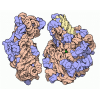
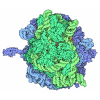

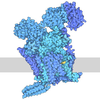
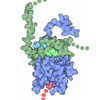


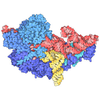


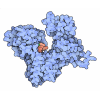

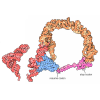






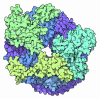








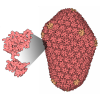
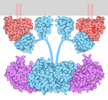

 Z (Sec.)
Z (Sec.) Y (Row.)
Y (Row.) X (Col.)
X (Col.)




















